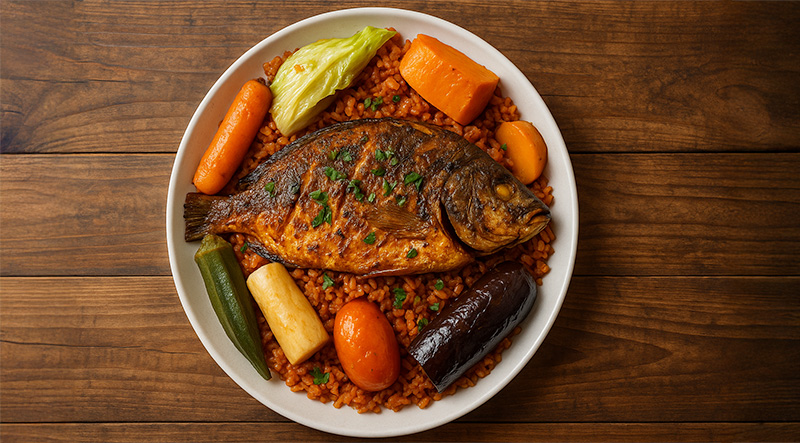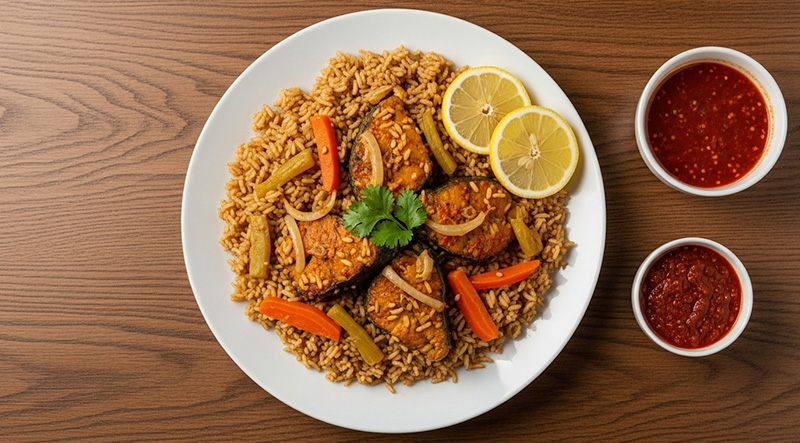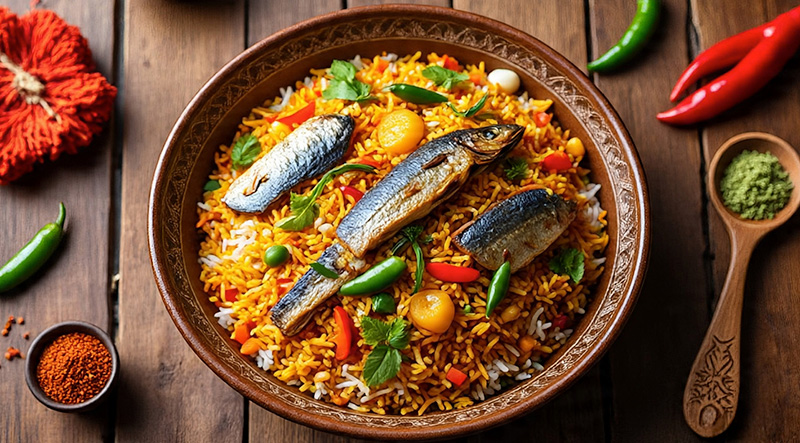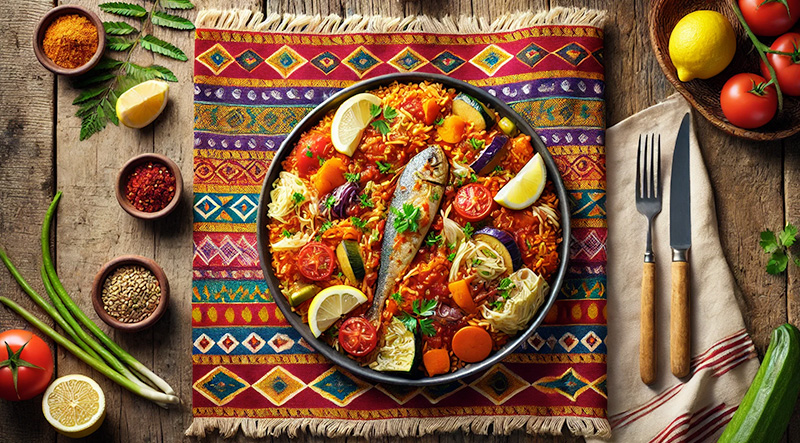The cherished national dish of Mauritania, **Thieboudienne**, is vibrant, filling, and bursting with strong coastal flavor, and it unites the entire table. Tender white fish, aromatic rice infused with tomatoes, and a variety of slow-cooked vegetables, including eggplant, carrots, and cabbage, are all combined in this hearty one-pot meal. The broth is infused with spices and flavor. Thieboudienne is more than just food; it's a delectable celebration of West African culinary soul and Mauritanian hospitality, traditionally served in a communal dish and consumed by hand. Read More...
The History of Thieboudienne – Mauritania’s Beloved National Dish:
Fragrant, colorful, and deeply rooted in West African culture, Thieboudienne (also spelled Chebujin or Ceebu Jën) is more than just Mauritania’s national dish—it’s a story of coastal tradition, cultural fusion, and culinary pride. Though often associated with Senegal, this flavorful fish-and-rice dish has been wholeheartedly embraced in Mauritania, where it is prepared and enjoyed with local twists, making it a symbol of community, identity, and everyday nourishment.
Origins in the Heart of West Africa:
Thieboudienne is believed to have originated in Saint-Louis, Senegal, a coastal city where fresh seafood, rice, and vegetables were abundant. Over time, the dish spread across the Sahel region, taking root in neighboring countries like Mauritania, where it evolved to reflect the local palate and ingredients.
The name “Thieboudienne” comes from the Wolof language—with thieb meaning “rice” and dienn (or jën) meaning “fish.” The dish began as a humble fisherman’s meal, combining the day’s catch with rice and whatever vegetables were available, simmered together in a richly spiced tomato broth.
Mauritania’s Coastal Connection:
In Mauritania, where the Atlantic coastline provides an abundance of white fish such as grouper, snapper, or sea bream, Thieboudienne became a natural fit. Coastal towns like Nouadhibou and Nouakchott made the dish a staple, integrating it into both daily meals and festive occasions.
What sets the Mauritanian version apart is its regional interpretation—often prepared with local spices such as cumin, garlic, black pepper, and dried chilies, and sometimes enriched with ingredients like cassava, eggplant, okra, and cabbage. The rice used is typically medium or broken rice, which soaks up the rich tomato and fish-infused sauce, creating a flavorful base that ties the dish together.
A Dish of Unity and Sharing:
In Mauritanian culture, Thieboudienne is more than a dish—it’s a communal experience. Traditionally, it is served on a large shared platter, with family members or guests gathering around to eat together by hand. This style of dining reflects a deep-rooted value in hospitality, unity, and respect.
Whether prepared for daily lunch, Friday prayers, or special celebrations, Thieboudienne plays a central role in bringing people together. It’s also a point of national pride—offering a taste of Mauritania’s geography, history, and generosity in every bite.
Cultural Variations and Modern Popularity:
While fish remains the star of the traditional Thieboudienne, Mauritanian cooks often adapt the dish with meat or chicken depending on occasion or availability. Spices vary from household to household, giving each version its own unique flair.
In cities and villages alike, Thieboudienne is prepared with time and care—often taking hours to layer the flavors and cook the ingredients to perfection. Despite modern conveniences, many Mauritanians continue to prepare the dish using traditional methods, including cooking in wide clay or metal pots and allowing the rice to gently toast at the bottom to create the prized crispy layer known as xarné.
With growing interest in global cuisine, Thieboudienne has begun to gain international attention as a West African culinary gem. It’s featured in cookbooks, food festivals, and cultural exchange programs as a dish that encapsulates flavor, nutrition, and history.
A Cultural Masterpiece on a Plate:
Rich in taste and rooted in tradition, Thieboudienne is a reflection of Mauritania’s coastal bounty and cultural depth. It is a meal that carries the warmth of shared experiences, the resourcefulness of local ingredients, and the pride of generations who’ve passed it down. Whether served by the seaside or in a desert village, this vibrant fish and rice stew remains one of the most enduring—and endearing—symbols of Mauritanian identity.
Marinate the Fish (Optional but Traditional):

Make the Tomato Base:

Add the Fish:
Add Vegetables:

Cook the Rice:
Assemble and Serve:

Tips & Notes:
Thieboudienne is a dish that speaks to the heart of Mauritania—coastal, communal, and full of soul. Whether for a special occasion or a comforting family meal, this iconic recipe offers a taste of tradition and togetherness.
The total preparation and cooking time for Thieboudienne is approximately 1 hour and 30 minutes to 1 hour and 45 minutes. This includes around 20–30 minutes of preparation, such as cleaning and marinating the fish, chopping vegetables, and measuring ingredients. Cooking time takes about 60–75 minutes, covering the sautéing of the base, simmering the fish and vegetables, and cooking the rice in the rich tomato broth. While the dish requires several steps, each builds flavor and tradition into this deeply satisfying, one-pot West African classic.
A single serving of Thieboudienne, based on the recipe provided (serving 4–6), contains approximately 600–750 calories. This includes about 200–250 calories from the fish, 250–300 calories from the rice (depending on portion size), and an additional 100–200 calories from the tomato paste, oil, and vegetables like carrots, cabbage, and eggplant. Optional ingredients like cassava, sweet potatoes, or added oil can increase the total further. Despite its rich flavor, Thieboudienne offers a well-balanced mix of protein, carbs, and fiber in every hearty, satisfying portion.







